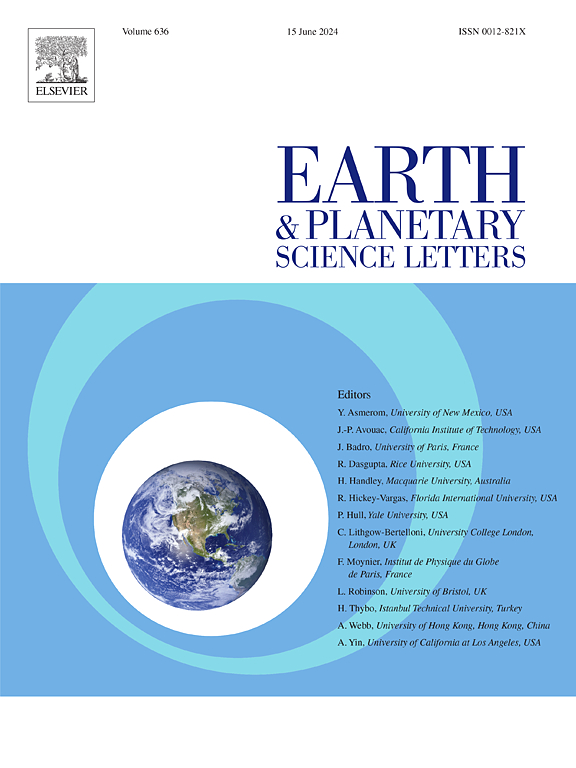纳斯卡板块测深异常的特征和地球动力学解释
IF 4.8
1区 地球科学
Q1 GEOCHEMISTRY & GEOPHYSICS
引用次数: 0
摘要
上涌羽流与海洋岩石圈之间的相互作用可以提供有关地球内部结构和动力学的重要线索。羽流衍生过程在不同深度、振幅和波长上扰动岩石圈。空间范围更广的过程是动态隆起,通常被描述为宽 1000 千米、高 1 千米的水深膨胀,而火山活动则是最集中的羽流表现。这两个终端过程通常分别以浮力通量和火山生成率等体积率来描述和测量。然而,中间过程,如岩石圈深度的岩浆捕集,虽然有报道,但研究仍然较少。为了更好地理解板块结构与羽流效应分布之间的关系,我们研究了相对快速而薄的大洋纳斯卡板块上地形羽流特征的空间分布。利用形态学标准,我们调整了两个滤波表面的宽度,从而将测深异常分为三个部分,分别反映了板块下方、内部和上方的形态特征。而区域性的膨胀部分则总括了纳斯卡板块的所有热点,宽度可达 2000 公里。我们假设这两个膨胀部分有不同的驱动过程,局部膨胀与岩石圈内领域有关,而区域膨胀可能与岩石圈下过程有关。本文章由计算机程序翻译,如有差异,请以英文原文为准。
Characterization and geodynamic interpretation of Nazca Plate bathymetric anomalies
The interaction between upwelling plumes and the oceanic lithosphere can provide important clues about the internal structure and dynamics of the Earth. Plume-derived processes disturb the lithosphere at different depths, amplitudes, and wavelengths. While the spatially wider process is dynamic uplift, commonly described as on the order of 1000 km wide and 1 km high bathymetric swell, volcanism is the most focused plume manifestation. These two end-members are commonly described and measured in terms of volumetric rates, such as buoyancy flux and volcanic production rate, respectively. However, intermediate processes such as magmatic trapping at lithospheric depths, although reported, has remained less studied. While the topographic separation between volcanic and regional (non-volcanic) features has numerous developments, the recognition of signatures of processes occurring at intermediate depths is a problem that has been less studied.
To better understand the relationship between plate structure and the distribution of plume effects, we investigated the spatial distribution of topographic plume signatures on the relatively fast and thin oceanic Nazca plate. Using morphological criteria, we adjusted the width of two filtered surfaces, which together allow us to divide the bathymetric anomalies into three components that could be reflecting morphological features supported below, inside, and above the plate.
The resulting decomposition suggests the existence of two superimposed components of swells on the Nazca plate, contrasting in distribution, morphology, and nature: local swells exhibit a clear spatial correlation with volcanic chains. The regional swell component in turn collectively encompasses all hotspots in the Nazca plate and show widths up to 2000 km. We hypothesize distinct driving processes for both swell components, with local swells connected to the intra-lithospheric domain and regional swells probably associated with sub-lithospheric processes.
求助全文
通过发布文献求助,成功后即可免费获取论文全文。
去求助
来源期刊

Earth and Planetary Science Letters
地学-地球化学与地球物理
CiteScore
10.30
自引率
5.70%
发文量
475
审稿时长
2.8 months
期刊介绍:
Earth and Planetary Science Letters (EPSL) is a leading journal for researchers across the entire Earth and planetary sciences community. It publishes concise, exciting, high-impact articles ("Letters") of broad interest. Its focus is on physical and chemical processes, the evolution and general properties of the Earth and planets - from their deep interiors to their atmospheres. EPSL also includes a Frontiers section, featuring invited high-profile synthesis articles by leading experts on timely topics to bring cutting-edge research to the wider community.
 求助内容:
求助内容: 应助结果提醒方式:
应助结果提醒方式:


